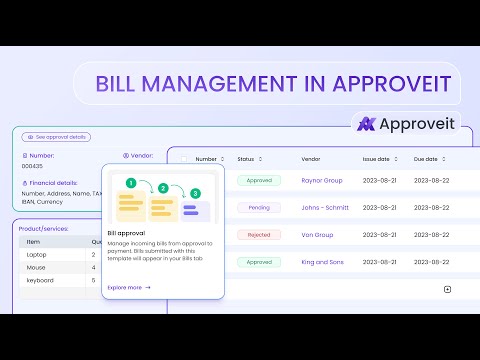Streamlining Financial Processes with Automated Accounts Receivable
S t r e a m l i n i n g F i n a n c i a l P r o c e s s e s w i t h A u t o m a t e d A c c o u n t s R e c e i v a b l e

Streamlining Financial Processes with Automated Accounts Receivable
In today’s fast-paced business environment, automated accounts receivable https://approveit.today/accounts-receivable-automation systems have become indispensable for companies looking to optimize their cash flow and enhance efficiency. Automated accounts receivable solutions enable organizations to streamline their invoicing processes, improve payment collection times, and reduce the risk of errors associated with manual invoice processing. This article delves into the many advantages of transitioning to an automated accounts receivable system, as well as tips for successful implementation.
The Need for Automation
The traditional method of managing accounts receivable often involves cumbersome manual processes, including data entry, invoice generation, and follow-ups on outstanding payments. These methods can be time-consuming and prone to human error, which may lead to delayed payments and cash flow issues. Moreover, businesses risk losing money due to overlooked invoices or lost payment documentation. To mitigate these challenges, companies are increasingly turning to automated accounts receivable systems that can manage the entire invoicing cycle efficiently.
Benefits of Automated Accounts Receivable
1. Improved Cash Flow
One of the primary advantages of automated accounts receivable is the positive impact on cash flow. With automation, invoices are generated and sent promptly once goods or services are delivered. Furthermore, many automated systems include features such as reminders for upcoming payments and following up with customers on overdue invoices, which helps accelerate payment timelines and ensures a steady cash flow.
2. Enhanced Accuracy and Reduced Errors
Automating the accounts receivable process minimizes the risk of human error. Manual data entry can lead to significant mistakes, including incorrect invoice amounts, wrong customer details, or inaccurate billing terms. Automated systems eliminate these errors by integrating with existing accounting software and verifying data in real-time, ensuring that invoices are accurate and consistent.
3. Time Savings
In any organization, time is a valuable resource. Automation significantly reduces the time spent on administrative tasks related to accounts receivable. With an automated system, employees can focus on higher-priority responsibilities rather than spending hours generating invoices or chasing down payments. The time saved can be redirected to enhancing customer service or developing strategic initiatives that drive business growth.
4. Enhanced Customer Experience
An automated accounts receivable system can improve the overall customer experience. By providing electronic invoices, customers can quickly receive and review their bills without the delays associated with postal delivery. Additionally, automated reminders and payment options can help customers manage their invoices more efficiently, leading to quicker payments and a better customer relationship.
Key Features of Automated Accounts Receivable Systems
When considering an automated accounts receivable solution, businesses should look for several key features that can lead to efficient management of their invoicing processes:
1. Electronic Invoicing
Electronic invoicing allows businesses to send invoices via email or through an online portal, providing a quick and efficient way to bill customers. This feature often includes customizable templates to align with branding and can improve the likelihood of timely payments.

2. Integration with Accounting Software
Choosing an accounts receivable system that integrates with existing accounting and ERP software is crucial. This integration ensures that data is synchronized between systems, reducing the likelihood of errors and providing a comprehensive view of a company’s financial health.
3. Automated Payment Reminders
Automated systems can send reminders to customers when payments are due or overdue, helping to ensure timely receipts and reducing the need for manual follow-ups. This feature is especially helpful in maintaining good customer relationships while also being assertive about payment obligations.
4. Reporting and Analytics
Robust reporting and analytics capabilities allow businesses to monitor their accounts receivable performance, identify trends, and forecast cash flow needs. These insights can guide decisions regarding credit policies and customer relationships.
Implementing Automated Accounts Receivable
Transitioning to an automated accounts receivable system can seem daunting, but with careful planning, it can be a seamless process. Here are some steps to consider for a successful implementation:
1. Assess Your Current Process
Before implementing an automated system, evaluate your current accounts receivable process to identify bottlenecks, pain points, and areas for improvement. Understanding your existing workflow will help in selecting the right solution that addresses your specific needs.
2. Choose the Right Software
Research various accounts receivable automation tools available in the market. Look for systems that align with your business size, industry, and financial goals. Consider trial versions or demos to ensure that the software meets your expectations.
3. Train Your Team
Effective implementation of automated accounts receivable systems requires training staff on the new processes and software. Ensure that your team is comfortable using the system and understands the benefits it brings to their roles.
4. Monitor Performance
After implementation, continuously monitor the performance of the automated system. Track key performance indicators (KPIs) such as average collection times and outstanding invoices to evaluate the system’s effectiveness and make adjustments as needed.
The Future of Accounts Receivable
As technology continues to advance, the landscape of accounts receivable is evolving. Automated systems are becoming increasingly sophisticated, incorporating artificial intelligence and machine learning to enhance decision-making and predictive analytics. Businesses that adopt these innovations will be better positioned to navigate the financial challenges and opportunities of the future.
Conclusion
Automated accounts receivable solutions offer businesses a pathway to increased efficiency, improved cash flow, and enhanced customer relations. By leveraging technology to streamline invoicing and payment processes, organizations can redirect valuable resources toward strategic initiatives and growth. As the financial ecosystem continues to evolve, embracing automation in accounts receivable is not just beneficial—it’s essential for sustained success.

Katerina Monroe
@katerinam • More Posts by Katerina
Congratulations on the award, it's well deserved! You guys definitely know what you're doing. Looking forward to my next visit to the winery!
